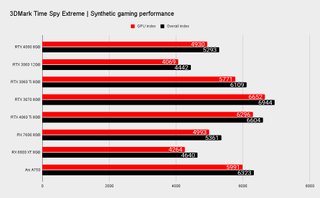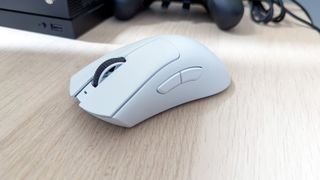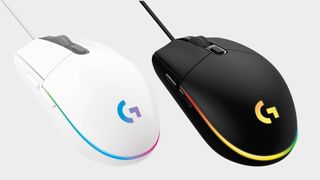Best gaming PC builds: budget, mid-range and high-end recommendations
From an $800 penny-saving PC to a $4,000 monster.

For those about to build a gaming PC, we salute you. We're big fans of building your own PC here at PC Gamer—not only is it often cheaper than buying a pre-built but you get to learn all about how a PC is pieced together. That can be incredibly helpful knowledge if you ever need to upgrade or troubleshoot your machine.
The first step to building your own PC is choosing your components. Below you'll find three gaming PC builds, starting from a sub-$900 build to an all-out overkill rig at over $4,000. All the hardware in this guide are the parts I'd pick if I were building my own PC, and using my own experience and our expert reviews to guide me. The key components have been tested on our test bench to ensure they meet expectations.
If this isn't what you're looking for, you can skip the whole building thing and get one of the best gaming PCs prebuilt or snap up a cheap gaming PC instead. But trust me, PC building can be a whole lot of fun and it's usually the far cheaper option. Go on, give it a go.
Best budget gaming PC build

| Category | Part | Current price (US) | Current price (UK) |
|---|---|---|---|
| Motherboard | ASRock B660M Pro RS | $100 | £115 |
| Processor | Intel Core i5 13400F | $208 | £199 |
| Graphics card | Nvidia GeForce RTX 4060 | $300 | £288 |
| Cooler | Laminar RM1 | Included with CPU | Row 3 - Cell 3 |
| Memory | Teamgroup T-Force Vulkan Z 16GB | $33 | £40 |
| Power supply | Be Quiet! Pure Power 12 M 550W | $95 | £91 |
| SSD | WD Black SN770 500GB | $33 | £35 |
| HDD | N/A | Row 7 - Cell 2 | Row 7 - Cell 3 |
| Case | Aerocool Zauron | $60 | £32 |
| Total | Row 9 - Cell 1 | $829 | £800 |
For this budget build, I'm opting for one of my favourite processors right now, the Intel Core i5 13400F. It's a plucky chip considering its price point, and Intel has bumped the number of E-cores on the chip compared to the 12th Gen model. That makes it a decent multithreaded processor, while simultaneously the speedier P-cores favoured for gaming keep things buttery smooth fps-wise.
The added benefit of this 13th Gen Intel chip is that we can opt for a motherboard with DDR4 support. Nowadays, DDR5 is the memory of choice for high-end machines, but when you get down to a budget level it's not quite as affordable. DDR4 RAM, and RAM in general, is extremely cheap nowadays, and that's why we're stuffing 16GB of 3,200MHz RAM into this machine, with a CAS latency of just 16.
I've tried to save as much cash as possible in this build to spend that money on one key component: the graphics card. Nvidia's RTX 4060 is a decent all-rounder for the money, and while we would love it to be a little cheaper, it does come with the benefit of DLSS 3 and good ray tracing chops.

There are a couple of alternative GPU picks: either going cheaper with a last-gen RDNA 2 GPU like the RX 6600 XT or bumping up to the RX 7700 XT found in our mid-range PC build, though the latter is around $150 more expensive than the RTX 4060 and, to be honest, we wish it were the RX 7800 XT. But now I'm just day-dreaming of better GPUs.
For the purpose of this build, I want to nail 1080p performance. The RTX 4060 does just that.
One key component I don't recommend you skimp on is the power supply. We used to have a somewhat cheaper XPG PSU in our build guides, the Pylon 450, but it's mostly unavailable nowadays—at least for a fair price. That's why I've bumped up to the Be Quiet! Pure Power 12 M 550W—another PSU maker we've reviewed well in recent years. It's enough juice for this GPU/CPU combo, while coming with some modern features. Be Quiet! use a solid platform for their power supplies, so you can rest easy knowing that your PC is safe from dodgy power.

As for storage, I've opted for our favourite SSD on the cheaper side of things: the WD Black SN770. Now don't let this SSDs price fool you, it's extremely fast. It's going to be a superb and snappy boot drive, and you really can't fault it on price. Originally I had a 500GB drive in here, alongside a 1TB HDD, but as the 1TB SN770 isn't much more money so I killed the HDD for the larger solid-state storage. A deal I'd make every time.
Lastly, the chassis. This is a tricky one, as if you really want to save pennies I recommend the Aerocool Zauron that I reviewed in 2022. Thing is, that isn't the easiest case to find in the US anymore, and even in the UK it appears to be in the process of being replaced by newer models. You can't really go wrong with most of Corsair's cheaper Carbide cases in my experience. If in doubt, take a look into the Carbide 175R.
Overall, this budget PC doesn't drop the ball on any of its components. It's certainly better than what you'd buy for the same cash pre-built, and I'm sure it'll last you years to come without running into trouble. Though I can't vouch for your building ability. Patience and care—two very important aspects of PC building any of us would do well to remember.
Best mid-range gaming PC build

| Category | Part | Current price (US) | Current price (UK) |
|---|---|---|---|
| Motherboard | MSI MAG B660M Mortar Max WiFi | $160 | £177 |
| Processor | Intel Core i5 13400F | $208 | £199 |
| Graphics card | AMD Radeon RX 7700 XT | $449 | £430 |
| Cooler | Laminar RM1 | Included with CPU | Row 3 - Cell 3 |
| Memory | Corsair Vengeance LPX 16GB (2x 8GB) DDR4-3200 | $40 | £36 |
| Power supply | Be Quiet! Pure Power 12 M 650W | $105 | £107 |
| SSD | WD Black SN770 1TB | $51 | £42 |
| HDD | N/A | Row 7 - Cell 2 | Row 7 - Cell 3 |
| Case | NZXT H7 | $130 | £100 |
| Total | Row 9 - Cell 1 | $1143 | £1091 |
For our mid-range build, I'm recommending the same processor as the budget build: the Intel Core i5 13400F. Yep, I'm sticking to my guns here, and there's good reason for it. I want the benefit of this cheaper processor and money-savvy DDR4 RAM to keep plenty of cash aside for the graphics card.
Originally I had picked the RTX 4060 Ti for this build. Mostly because, at the time, it was the only current generation GPU in the correct price bracket, and importantly beat out the RTX 30-series and RDNA 2 cards it solely competed with. However, AMD just dropped the RX 7700 XT and RX 7800 XT, which are priced as such to completely rule out the RTX 4060 Ti from any of my builds.
Now, I'd love to say the RX 7700 XT is a home-run, but it's not. It's priced so closely to the RX 7800 XT that I'd wholly recommend splashing out on the higher-end card. That said, I have to confine myself to some sort of budget for these machines, and the RX 7800 XT tipped this build guide over the edge.

For now, we'll stick with the RX 7700 XT, but know if you have any spare budget for this machine, I'd wholeheartedly recommend spending it on swapping to the RX 7800 XT.
For RAM, I've stuck with a tried and tested dual-stick kit of Corsair's Vengeance DDR4, rated to 3,200MHz. It's a fast, dependable kit that looks nice to boot.
Since we need a bit more power budget for this build versus the budget build, I've gone with the Be Quiet! Pure Power 12 M 650W here. It's a great platform, and a trusted manufacturer. You definitely don't want to pinch too many pennies when it comes to your power supply—that can have dire consequences. Best to play it safe and spend a little extra for peace of mind.
The WD Black SN770 rounds out this build. It's a great little NVMe that will work as an excellent boot drive with room to spare for your gaming library.
Lastly, the NZXT N7 case. If you're spending this sort of budget on a gaming PC, you want it to look good too. The NZXT is an absolute stunner, and it's well finished to look great under your desk or on it. The other benefit is NZXT's great cable management in the rear of the case and the tidy shrouds in the front, which mean you don't have to worry about too many zip ties or ugly cable runs visible through its tempered glass side panel.
Best high-end gaming PC build

| Category | Part | Current price (US) | Current Price (UK) |
|---|---|---|---|
| Motherboard | MSI MEG X670E Ace | $699 | £715 |
| Processor | AMD Ryzen 9 7950X3D | $682 | £669 |
| Graphics card | Nvidia GeForce RTX 4090 | $1660 | £1,500 |
| Cooler | NZXT Kraken X63 | $170 | £155 |
| Memory | G.Skill Trident Z5 RGB 32GB (2x 16GB) | $110 | £118 |
| Power supply | Seasonic Prime TX-1000 | $310 | £340 |
| SSD | WD Black SN850X 2TB | $120 | £110 |
| HDD | Crucial P5 Plus 2TB | $98 | £96 |
| Case | Corsair 5000D | $155 | £140 |
| Total | Row 9 - Cell 1 | $4004 | £3843 |
This is it, the daddy of PC builds. I've spared no expense putting this one together, and was pleasantly surprised it only amounted to a cool $4,000 when I totalled all the parts up. Oof. It may not be the cheapest but this PC will tear through any game you throw at it, any video editing task you want to get done, and make short work of at least a handful of Google Chrome tabs.
At its heart lies the AMD Ryzen 9 7950X3D. What can't this chip do? It's a mega-multitasker, with 16 Zen 4 cores capable of running up to 32 threads—your task manager won't know what to make of all those cores.
What makes the Ryzen 9 7950X3D a gaming powerhouse is the extra 3D V-Cache stacked atop of its cores. This chip comes with 128MB of L3 cache, double the regular Ryzen 9 7950X. Games can't get enough of the stuff, and this chip is demonstrably quicker in gaming than any other around today. It's the perfect chip to pair with a high-end graphics card, and I have just the thing in mind.
The RTX 4090. Did you expect anything less? Of course not. This graphics card offers unbeatable performance, and frankly it's a better deal, in terms of performance per dollar, than the RTX 4080 that sits below it in the stack. While equalling the amount some would spend on a car, it is an extremely proficient graphics card that makes short work of 4K gaming.

There are no real surprises for the rest of the build, either, besides maybe the SSD. I've opted for 2TB of our favourite PCIe 4.0 storage here, the WD Black SN850X, rather than a 'just-for-the-sake-of-it' PCIe 5.0 drive. We will reach a time when PCIe 5.0 makes more sense, but it's not really today. This drive, paired with another 2TB of decently-quick Crucial storage, will offer plenty of space for your Steam library.
I couldn't really opt for anything less than 32GB of DDR5 here, and make no mistake we are going all-in on the newer memory standard here. Prices have come tumbling down for DDR5 as of late, so it's not such a hit on our budget as it once was.

The PSU matters for a lot with this build, as it's the lifeblood of all these expensive components. I've opted for the Seasonic Prime TX-1000 to ensure a robust platform with extremely high efficiency.
All that is wrapped up in the Corsair 5000D: a lovely looking case with tons of expansion room. I also have the Corsair 5000T for my PC build at home, and I'd recommend that as an alternative for the RGB obsessed. Either way, there's plenty of airflow getting to those high performance parts.
There's plenty of opportunity to configure this build to your liking with a couple tweaks here or there, but the important thing is it's going to absolute crush any game you throw at it.
Monitors, peripherals, and other important bits
PC Gamer's got your back
Below are a few of our favourite monitors and peripherals you may wish to check out if you're entirely starting from scratch in PC gaming.
High-end picks

Glossy goodness lets Alienware's cheaper OLED monitor sing
For
- Glossy coating makes all the difference
- Ultra-quick response
- Good full-screen brightness
Against
- Still fairly pricey
- Mediocre pixel density
Budget picks

Proof positive that good gaming hardware doesn't have to be painfully pricey.
For
- Zippy IPS panel
- 165 refresh and good latency
- Slick, well-built chassis
Against
- Very limited HDR support
- 'Only' 1080p
- Silly OSD menu and options
PC Gamer Newsletter
Sign up to get the best content of the week, and great gaming deals, as picked by the editors.

Jacob earned his first byline writing for his own tech blog. From there, he graduated to professionally breaking things as hardware writer at PCGamesN, and would go on to run the team as hardware editor. Since then he's joined PC Gamer's top staff as senior hardware editor, where he spends his days reporting on the latest developments in the technology and gaming industries and testing the newest PC components.
Most Popular





